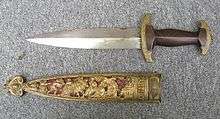Swiss dagger
The Swiss dagger (Schweizerdolch) is a distinctive type of dagger used in Switzerland and by Swiss mercenaries during the 16th century. It develops from similar dagger types known as basler which were in use during the 14th and 15th centuries. The characteristic mark of the Swiss dagger are two crescent-shaped, inward-bent metal bars delimiting the hilt.
The curved shape of the Swiss dagger hilt appeared as early as the 13th century and remained peculiar to Switzerland, and do not appear to have been imitated elsewhere. The blade was characteristically double edged, tapering to a point and was, on earlier examples, sometimes diamond shape in cross-section.
One of the masterpieces of Hans Holbein the Younger is a design for a dance of death on the sheath of such a dagger (which was implemented on a number of surviving examples),[1] and for this reason the Swiss dagger has sometimes also been referred to as "Holbein dagger".

After 1550, the Swiss dagger became a prestigious ornamental weapon, with hilt and sheath decorated with precious metal and scenes from the Bible, classical antiquity or Swiss history. The Swiss dagger disappears after 1600. About 150 specimens in the style of the late 16th centuries are known worldwide, but more than half of this number are modern imitations.
The ordnance dagger issued to officers in the Swiss Armed Forces was modeled after the historical Swiss dagger in 1943.
In Nazi Germany, the hilts of some political and military daggers (worn by members of SS (pictured), SA, and NSKK formations) were modelled on the Swiss dagger.
See also
References
- ↑ E. A. Gessler, 'Eine Schweizer Dolchscheide mit der Darstellung des Totentanzes', in: Schweizerisches Landesmuseum in Zürich, Jahresbericht 39 (1930), 82-96.
- Franz Egger: Schweizerdolch in German, French and Italian in the online Historical Dictionary of Switzerland.
